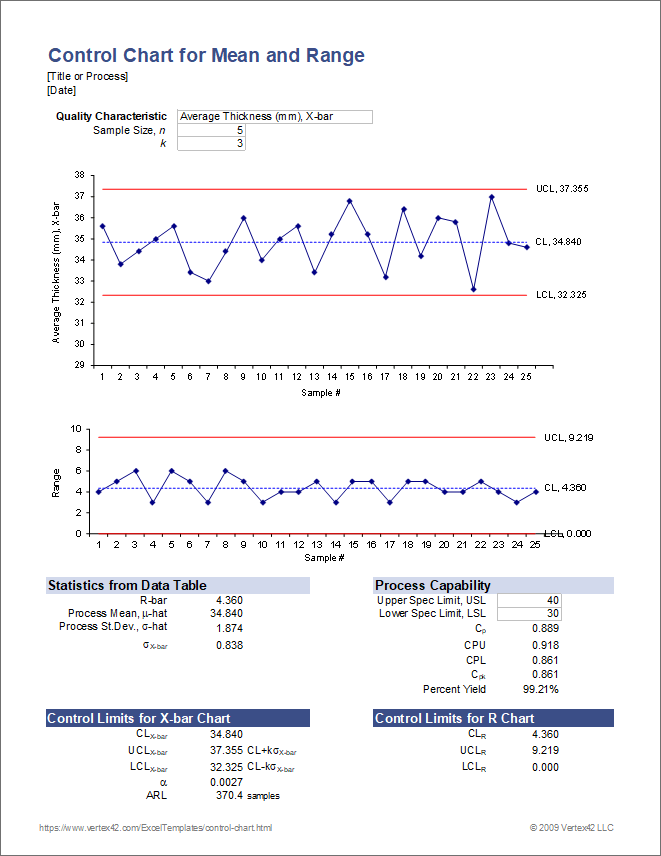
If a process is in control, the points will vary randomly around the center line. Use the center line to observe how the process performs compared to the average. The center line is the horizontal reference line on a control chart that is the average value of the charted quality characteristic. What is the center line on a control chart?

#Spc formulas excel how to
In other words, they provide a great way to monitor any sort of process you have in place so you can learn how to improve your poor performance and continue with your successes. The purpose of a control chart is to set upper and lower bounds of acceptable performance given normal variation. What is the main purpose of a control chart?Ĭontrol charts have long been used in manufacturing, stock trading algorithms, and process improvement methodologies like Six Sigma and Total Quality Management (TQM). SPC and Statistical Process Improvement > There are various types of control charts which are broadly similar and have been developed to suit particular characteristics of the quality attribute being.Find the mean of all of the means from the previous step (X).To find the mean, add all measurements in the subgroup and divide by the number of measurements in the subgroup. Check to see that your data meets the following criteria: Data should usually be normally distributed revolving around a mean (average).Objectives: Create and edit formulas using relative, absolute, and mixed cell references. In this Fred Pryor Seminars_Excel Control Chart_Practice sample, play around with the numbers to see how the average and other limit lines change when data shifts or try this process out yourself.Frequently Asked Questions How to set up a control chart? Previous Excel experience suggested before taking this class. Click OK to confirm and your Excel control chart will be complete. Repeat this action for your “Upper” and “Average” data sets. When the menu opens, choose a line chart.
#Spc formulas excel series
Right-click a data point on your Lower limit line and select Change Series Chart Type. This allows formulas to spill across multiple cells if the formula returns multi-cell ranges or arrays. In September, 2018 we announced that Dynamic Array support would be coming to Excel. The chart may look complete, but it isn’t in the proper format just yet. Excel functions that return ranges or arrays. Choose a Scatter chart type.įor the final step, you need to establish the field areas for your deviation.

Now that you have the framework for your Excel control chart set up and your data imported, select the data in columns B through F and navigate to the Insert tab and locate the Chart group on the menu. After you hit enter, autofill the formula down to the end of your data. In the Lower column, do the same with the formula =Average(C:C)-2.66*Average(A:A), and in the Upper column use =Average(C:C)+2.66*Average(A:A).įinally, set up the formula for your Average column. Select the cell and drag it down to copy the formula to the end of your data. In the first cell of the Range column, enter the formula =Abs(C2-C3). Fill the Data column with your organized data points, and fill the Number column with values ascending in numerical order, starting with 1. Label them Range, Number, Data, Lower, Upper and Average.

Secondly, create columns to organize your data. If it’s not, your control chart will not be useful. a target point that the data points are clustered around. Techniques include control chart, process capability. Your data set should be organized along a mean (average) – i.e. Learn how you easily perform statistical charting and analysis in the familiar environment of Excel. Once you have the data gathered from your process, the first step in creating an Excel control chart is to ensure that it is correctly formatted. They can easily illustrate whether your process is operating within its intended parameters. Modify the equations to adjust the control limit calculations.

Control charts are useful for monitoring any process that has a level of variation – for example, filling containers with a certain number of items. Introduction to SPC for Excel SPC for Excel is a statistical analysis package that. In this article, we’ll show you how to construct an Excel control chart to analyze data and improve efficiency. Categories: Advanced Excel Tags: Excel control chart


 0 kommentar(er)
0 kommentar(er)
